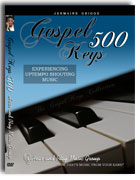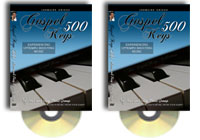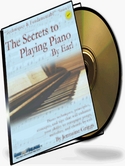requested literally hundreds of times. We're talking about how to play "fast, uptempo shouting music" by ear. Now, we realize if you are a jazz or blues player, you're probably wondering what the heck is
"shouting music." Basically, it's a very specific style of gospel playing that is used in church
during high periods of praise. For an audio sample of shouting music, click below: http://playaudio-234.com/play.asp?m=257323&f=KZHHYD&ps=7&p=1 ...Fast huh? Most styles of shouting music are very fast, energetic, and exciting. If your children tend to fall
asleep during church, take them to a church that "shouts" and you should never have that
problem again (smile). While the lesson below will cover major concepts associated with shouting music, if you're really
interested in learning, step-by-step and over-the-shoulder, how to play shouting music by ear,
you may want to check out our newest gospel resource, GospelKeys 500 - "Experiencing
Uptempo Shouting Music" 2-hour dvd course. You'll learn, step-by-step:
 ===> How to master shouting music by learning our never-before-seen
===> How to master shouting music by learning our never-before-seen techniques. I break shouting music into three key sections: "The Shouting
Intro," "The Main Loop Period" and "The Cool-down." You'll explore
each part, step-by-step. I guarantee that you won't find shouting music
taught in these 3 steps ANYWHERE ELSE! More info... ===> Discover the secrets to effectively playing shouting music and how
to properly begin and end your playing naturally. This is one of the most
awkward things in shouting music: The beginning and ending. ===> The power of tritones in shouting music and how they allow your right hand to play fast-
moving movements, fill-ins, and runs at double the speed! ===> How to play common shouting songs like "When I Think of the Goodness of Jesus"
(aka "I Can Dance, Dance, Dance ALL NIGHT!"). Every musician should know this version of
shouting music because it's bound to pop up sooner or later in someone's church service! More
info... ===> How to play left-hand bass runs, right hand chordal movements, and fill-ins (all covered
in our "Main Loop Period" section) at high tempos and how to keep the speed of your shouting
music consistent at all times!
 ===> The difference between praise songs and shouting music and how
===> The difference between praise songs and shouting music and how to determine whether to play in a linear or non-linear style. Tip: Shouting
music, for the most part, is non-linear (no particular order). You'll also
learn linear shouting patterns that are common among gospel bands these
days. ===> How to use modulation to increase the intensity of your playing
during the highest points of the shouting period. This "constant
modulation" is heard in many gospel songs and you'll be able to apply it to
your shouting music immediately! ===> How to add flavor to your shouting music by exploring various advance techniques like
"stride piano," "modulation," "role reversal," "linear shouting patterns," and a lot more! More
info... ===> How to play "prepared and planned" shouts that all instruments can follow (bass,
organ, piano, guitar). This is what I call "linear shouting patterns." Learn the ins and outs of
changing keys and how to make sure all instruments are on the same page!
 ===> How to start a "shout" from scratch! We've found that it is very difficult for musicians to initially start shouting music during a high praise part of the church service. We'll show you several versions of what we call "The Intro" and how to make the beginning of your shouting music sound natural! More info...
===> How to start a "shout" from scratch! We've found that it is very difficult for musicians to initially start shouting music during a high praise part of the church service. We'll show you several versions of what we call "The Intro" and how to make the beginning of your shouting music sound natural! More info...
 "The Secrets to Playing Piano By Ear" 300pg Course - Learn the "The Secrets to Playing Piano By Ear" 300pg Course - Learn thesecrets to playing literally any song on the piano with a few simple, "easy-to-understand" techniques and principles! Join Jermaine Griggs in learning tons of music theory, concepts, and tricks that will help you to learn piano by ear! Thousands of musicians have already taken advantage of this excellent program ... why not you? "The Secrets to Playing Piano By Ear" is full of easy-to-understand |
------------------------------------------------------------------------ Online Classroom: 'How to play fast, uptempo shouting music by ear!' ------------------------------------------------------------------------ Note: You might want to print this lesson out for easier reading... Shouting music is one of my favorite topics because at the tender age of 8-years old, it was
probably one of the few things I had to master very quickly. By 10, I was playing for several churches (COGIC, Baptist, Apostolic, Pentecostal) and most of
them "shouted" for at least 30 minutes during each service. ...So needless to say, I got good very quickly at playing fast left-hand bass runs, right-hand
chordal movements, and more! In this lesson, I'm going to show you some of the essentials to playing shouting music by ear.
If you have no idea what shouting music is or how it sounds, click on the link belowIn fact, we're going to be using the same concepts from GospelKeys 500 for the online classroom
to hear a sample: http://playaudio-234.com/play.asp?m=257323&f=KZHHYD&ps=7&p=1
lesson below. The first concept to master is the left-hand bass run because it provides the foundation and
rhythm for your shouting music. Concept #1: Left-hand bass runs There are tons of bass runs that can be used in shouting music. If you listen to the sample above,
you'll hear a variety of different "runs." Some runs move downward (from high notes to low
notes). Other bass runs (aka "bass lines") move in an ascending direction. MAJOR KEY: We'll be in the key of Ab major for this lesson. Let's learn a few ascending and descending bass runs. Ascending bass run (1-5): Ab C Db D Eb F Gb G Ab Note: These notes are played separately, one after the other (not together)! Tip: If you were to imitate the sound of a "shout" by stomping your feet and clapping your
hands right after (that is: "stomp - clap - stomp - clap - stomp - clap"), your bass notes would be
played on every beat, each time you stomp and clap). Descending bass run (1-5): Ab Gb F E Eb F Gb G Ab Notice that we called both of the examples above "1-5" bass runs. Why? Because they focus on the 1st and 5th keys of the scale. Let's look at the Ab major scale: Ab major: Ab Bb C Db Eb F G Ab If you were to place a number (starting at 1) by each of these notes, Ab would have a number
"1" by it and Eb would have a number "5" by it. Since the bass runs above are both focused on Ab and Eb, they are called "1-5" bass runs. You can also "1-4" bass runs in shouting music. I'll give you a few below: Ascending bass run (1-4): Ab Bb B C Db F Gb G Ab Descending bass run (1-4): Ab Gb Eb D Db F Gb G Ab Congratulations. Now you have four bass runs to practice. In GospelKeys 500, you get many more to choose
from. If you're really into this style of playing, We highly recommend it. So now that you have the left hand taken care of, We recommend that you practice it with a
metronome. Metronomes are little $15 devices that keep rhythm for you at different speeds. You can choose
the tempo so you can start off slow and build your speed as you get better. Also, if you have a keyboard with rhythmic and performing features, you can find "shouting
rhythms" to accompany you while you practice these bass runs. The key is having some type of
rhythmical device to keep your "timing" as you practice. Once you've mastered the left hand, there's many things to do on your right hand. Concept #2: Right-hand chordal movements While there are tons of things to do on your right hand, understanding how "13th" chords work
is essential. A thirteenth chord is built on the (1), (3), (5), (b7), (9), (11), and (13) tones of a major scale. In C major, that would be: C + E + G + Bb + D + F + A (this time, played together). Now... Obviously, that's a lot of notes and most gospel musicians don't play thirteenth chords like that. An easier route is to play the C on your left hand and just play the Bb + D + F + A on your right
hand. If you can reach, try adding in a high C and playing Bb + D + F + A + (C). C13 (abbreviated): C on left /// Bb D F A (C) on right. Now, let's bring that formula to Ab major. Ab13 = Ab on left /// Gb Bb Db F (Ab) on right. Putting it all together Playing an Ab13 in a rhythmic fashion over an Ab ascending or descending bass run is the
foundation of shouting music. This combination, alone, can be played the entire time. The only thing is... ...Because shouting music is so repetitive (it's generally the same bass run over and over), you
want to include other things (like variations in bass runs and different right-hand chordal
movements and fill-ins) to spice things up. This is exactly the idea of GospelKeys 500 but I'll
show a few concepts below. Three main parts of shouting music 1) The "Intro" 2) The "Main Loop" Period 3) The "Cool Down" Part One: The Intro The Intro is the start of the "shouting" period. You won't find full-length ascending and descending bass runs like I've posted above. Instead, you have teasers like: C -- Db --- D --- Eb. Usually the C and Db are played in pairs and the D and Eb are played in
pairs. That's your left hand. As for your right hand, as shown in GospelKeys 500, you'll play something
like: Bb Eb Ab (over the "C" bass from above) B Eb F Ab (over the "Db" bass from above) B D F Ab (over the "D" bass from above) C Eb Ab (over the "Eb" bass from above) This generally repeats for a good amount of time. The "Main Loop" period will usually follow
right after. Part Two: The "Main Loop" Period You've already learned some things to do during the main loop period (concepts #1 and #2 from
above). This is the moment of your shouting music when the bass run is fully active (unlike the 4-note
bass runs used in the "intro"). You'll use full-powered ascending and descending bass runs along
with right-hand chordal movements. For now, you've learned that the Ab13 chord can be played
on your right while running the bass on your left hand. Other concepts that are covered in
GospelKeys 500 are: - Diminished chord tricks - Right-hand fill-ins - More Fill-ins: b3 and b5 fill-ins - Three "magic" chords - Pentatonic and blues tricks - Chromatic drops and more... Part Three: The "Cool Down" The "Cool Down" period is just what it sounds like. It's the moment where the shouting music is coming to an end but instead of just abruptly
ending, the cool down period allows you to play certain movements that are less active than the
main loop period. More information... Other sections: "Beyond the Basics" Other concepts covered in GK 500 "Experiencing Shouting Music" 1) Role Reversal Techniques 2) Stride / Ragtime Effects 3) Linear Shouting Patterns / Vocal Accompaniment 4) Modulation More information... We hope you enjoyed this month's lesson and we'll be back soon!
Explore these chord types to prepare for the GospelKeys video course:
- Major triads; see pg chapter 5 of 300pg course
- Minor triads; see pg chapter 8 of 300pg course
- Major sixth chords; see pg chapter 13 of 300pg course
- Minor sixth chords; see pg chapter 13 of 300pg course
- Seventh (dominant) chords; see pg chapter 10 of 300pg course
- Minor seventh chords; see pg chapter 10 of 300pg course
- Major ninth chords; see pg chapter 14 of 300pg course
Well, we hope you enjoyed this newsletter and we'll be back soon! Take care!
This concludes your Online Classroom Lesson If you were intrigued by the online classroom lesson above, then you would definitely benefit from our course! *** “The Secrets to Playing Piano By Ear” 300-pg Course ***
With 20 chapters and over 300 pages, the home piano course provides several
resources, techniques, tips, principles, and theories to playing the piano by ear.
Along with hundreds of chords and scales, you'll also learn how to turn them into
gospel, jazz and blues chord progressions and better yet, how to use them to play
ABSOLUTELY any song you want ... IN VIRTUALLY MINUTES! Again, don't miss this opportunity. we've even added an additional bonus if you
purchase the course this week --- You can read more about the course at: http://www.hearandplay.com/ggcourse
Enjoy this edition? Visit our message board and let us know! http://www.hearandplaymusic.com/ggboard.html Please let a friend know about GOD'S GOSPEL and HearandPlay! PLEASE FORWARD THIS
NEWSLETTER TO YOUR ENTIRE E-MAIL ADDRESS BOOK.
Yours Truly, Jermaine Griggs HearandPlay GospelKeys
Mel, Webminister of Music

GOD'S GOSPEL - http://www.godsgospel.com
Further References"The Secrets to Playing Piano By Ear" 300-pg Course [5] Chords & Progressions: pgs 65-78, 105-130, 147-165, 182-227.Do you know what a “2-5-1” or "3-6-2-5-1" progression is? Or perhaps the famous 12-bar blues chord progression? In this piano course, you will not only learn how to play gospel, blues, and jazz progressions, but how to recognize them in songs. In addition, you will learn the simple techniques to playing these progressions, hymns, and songs in all 12 major keys! ... Enjoy learning:
|
 "The Secrets to Playing Piano By Ear" 300pg Course - Learn the "The Secrets to Playing Piano By Ear" 300pg Course - Learn thesecrets to playing literally any song on the piano with a few simple, "easy-to-understand" techniques and principles! Join Jermaine Griggs in learning tons of music theory, concepts, and tricks that will help you to learn piano by ear! Thousands of musicians have already taken advantage of this excellent program ... why not you? "The Secrets to Playing Piano By Ear" is full of easy-to-understand |